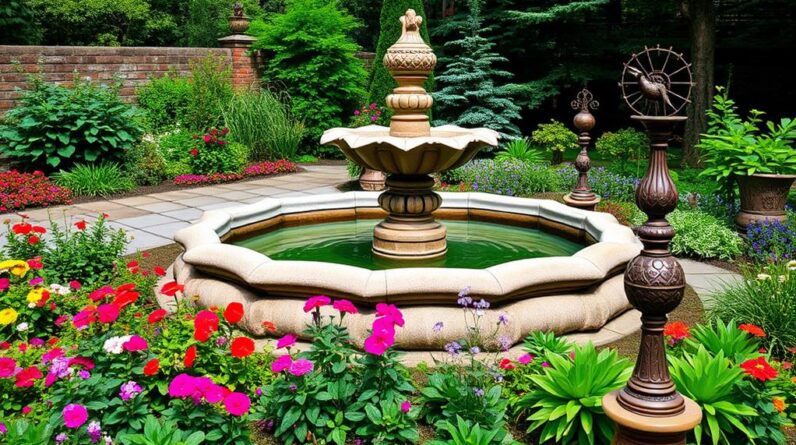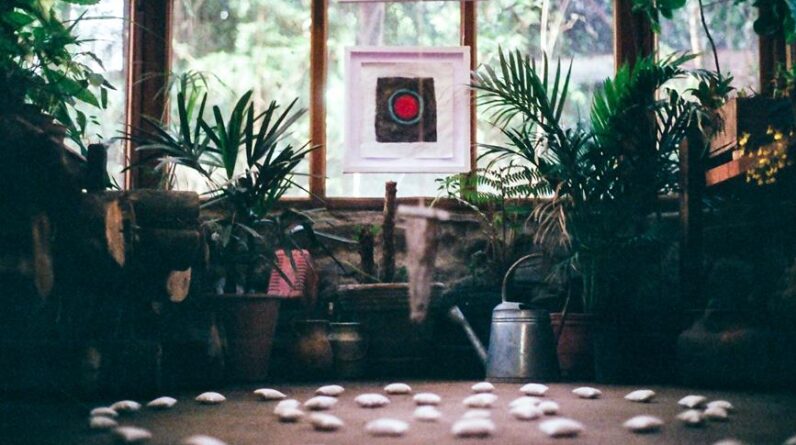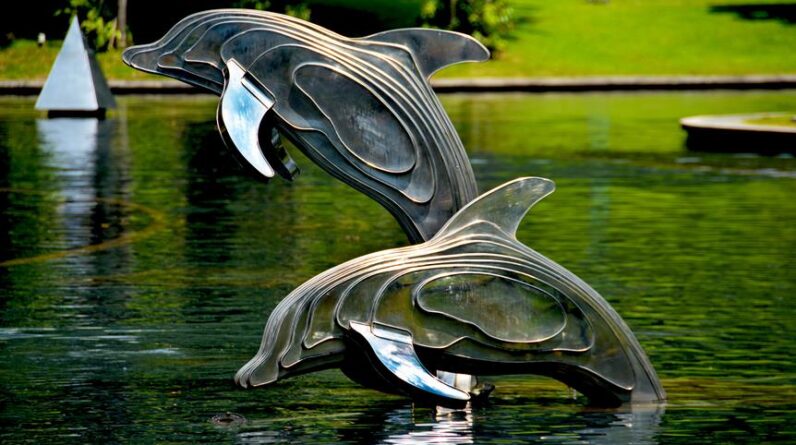
Imagine stepping into a sanctuary, where nature's embrace washes away stress and renews your spirit. In this therapeutic garden, carefully designed to heal and inspire, every element dances in harmony.
The power of nature melds seamlessly with innovative design principles, creating a space that soothes and rejuvenates. As you explore the enchanting flora and tranquil water features, you'll discover the transformative potential of healing spaces.
Get ready to embark on a journey of serenity and innovation as we delve into the art of designing a therapeutic garden.
Key Takeaways
- Immersion in nature has transformative effects on mental well-being
- Sensory stimulation engages sight, sound, touch, and smell
- Balance functionality and aesthetics in healing space design
- Water features enhance relaxation and serenity
The Power of Nature: Harnessing the Healing Benefits
You'll be amazed at the transformative effects of immersing yourself in nature's healing embrace. Ecotherapy, the practice of connecting with nature for mental well-being, has gained significant recognition in recent years.
Numerous studies have shown the positive impact that spending time in natural environments can have on our mental health and overall well-being. Biophilic design takes this concept a step further by incorporating natural elements into our built environments, creating healing spaces that promote a sense of calm and tranquility.
By surrounding ourselves with nature-inspired elements such as plants, natural light, and water features, we can create environments that nourish our souls and promote a sense of wellness. The therapeutic benefits of these spaces are undeniable, offering respite from the stresses of modern life and allowing us to reconnect with our innate connection to nature.
Elements of a Therapeutic Garden: Creating a Soothing Environment
Immerse yourself in the beauty and tranquility of a therapeutic garden, where you can find solace and peace. A therapeutic garden is carefully designed to create a soothing environment that promotes healing and well-being. Here are three key elements that contribute to its calming atmosphere:
- Sensory stimulation: A therapeutic garden engages all your senses, providing a multi-sensory experience. You can enjoy the sight of vibrant flowers and lush greenery, listen to the gentle rustle of leaves, feel the texture of different plants, and even enjoy the fragrance of aromatic herbs. This sensory stimulation helps to reduce stress and promote relaxation.
- Accessibility considerations: Designing a garden that's inclusive for all individuals is essential. Incorporating wheelchair-accessible paths, raised planters for those with limited mobility, and sensory elements at different heights ensures that everyone can fully enjoy the therapeutic benefits of the garden.
- Serene design elements: A soothing environment is created through thoughtful design choices. Incorporating elements like flowing water features, comfortable seating areas, and secluded corners allows for moments of quiet contemplation and reflection.
By creating a therapeutic garden that engages the senses and considers accessibility, you can foster a serene and inclusive space for healing and rejuvenation.
Now let's explore the design principles for healing spaces, where we'll discuss the delicate balance between function and aesthetics.
Design Principles for Healing Spaces: Balancing Function and Aesthetics
Create a harmonious balance between functionality and aesthetics when designing healing spaces to ensure a seamless integration of practicality and beauty. Incorporating modern advancements and accessibility considerations into therapeutic garden design allows for a more innovative and inclusive experience for individuals seeking healing and relaxation.
In order to achieve this balance, it's important to consider the integration of technology within the healing space. This can include features such as interactive displays that provide information on plants and their therapeutic benefits, or even virtual reality experiences that transport visitors to different natural environments for a more immersive healing experience.
Additionally, accessibility considerations should be at the forefront of the design process. This means ensuring that healing spaces are easily accessible for individuals with disabilities, incorporating features such as ramps, wide pathways, and sensory elements that can be enjoyed by all.
Plant Selection: Choosing the Right Flora for Therapeutic Gardens
Choosing the right flora for therapeutic gardens involves carefully selecting plants that promote healing and relaxation. The right combination of plants can provide sensory stimulation and therapeutic benefits, creating a soothing and rejuvenating environment.
Here are some factors to consider when selecting plants for a therapeutic garden:
- Colors: Choose plants with calming colors like blues, purples, and greens to create a tranquil atmosphere.
- Fragrance: Incorporate aromatic plants like lavender, chamomile, and rosemary to stimulate the senses and promote relaxation.
- Texture: Include plants with different textures, such as soft leaves, rough bark, or delicate flowers, to provide tactile stimulation.
Incorporating Water Features: Enhancing Relaxation and Serenity
To truly enhance relaxation and serenity in your therapeutic garden, consider incorporating a few carefully selected water features. Water has a remarkable ability to create a soothing and calming atmosphere, making it an ideal addition to any healing space.
The benefits of water features in a therapeutic garden are numerous. The gentle sound of flowing water can help drown out unwanted noise, creating a peaceful environment for relaxation and reflection. Additionally, the sight of water can have a calming effect on the mind, reducing stress and anxiety.
When designing water features for your garden, think about incorporating elements such as fountains, ponds, or waterfalls. These features can be strategically placed to create a sense of harmony and balance throughout the space.
As you sit in your garden, the sound of water trickling and the sight of its gentle movement will transport you to a place of tranquility and calm.
Frequently Asked Questions
How Can Therapeutic Gardens Benefit Individuals With Specific Medical Conditions?
Therapeutic gardens can benefit individuals with specific medical conditions by incorporating designing principles that promote relaxation and healing. Being surrounded by nature can have a calming effect and provide numerous benefits for your overall well-being.
Are There Any Specific Design Considerations for Creating a Therapeutic Garden in a Healthcare Facility?
When creating a therapeutic garden in a healthcare facility, it is important to consider specific design principles that promote healing and provide sensory stimulation. By incorporating these elements, you can create a space that truly benefits individuals with medical conditions.
What Research Has Been Conducted on the Effectiveness of Therapeutic Gardens?
Research findings on the effectiveness of therapeutic gardens show numerous benefits of nature, including reduced stress, improved mood, and increased overall well-being. It's amazing how something as simple as a garden can have such a profound impact on our health.
How Can Therapeutic Gardens Be Used in Conjunction With Other Therapies or Treatments?
Imagine the possibilities of integrating therapeutic gardens with psychotherapy, combining the healing power of nature with the transformative potential of talk therapy. Or picture the synergy of therapeutic gardens with physical rehabilitation, where the body and the garden work together to promote healing.
Are There Any Guidelines or Regulations for Designing and Implementing Therapeutic Gardens in Public Spaces?
When designing therapeutic gardens in public spaces, it's important to consider guidelines and regulations. These ensure that the spaces are accessible, safe, and meet the needs of those seeking healing and relaxation.
Conclusion
As you step into a therapeutic garden, a sense of calm washes over you like a gentle breeze.
The vibrant colors of the flowers symbolize hope and renewal, while the trickling water features represent tranquility and healing.
Every element of this space has been carefully designed to create a soothing environment that nurtures your mind, body, and soul.
Nature's power to heal is beautifully captured in this garden, inviting you to find solace and rejuvenation amidst its peaceful embrace.












